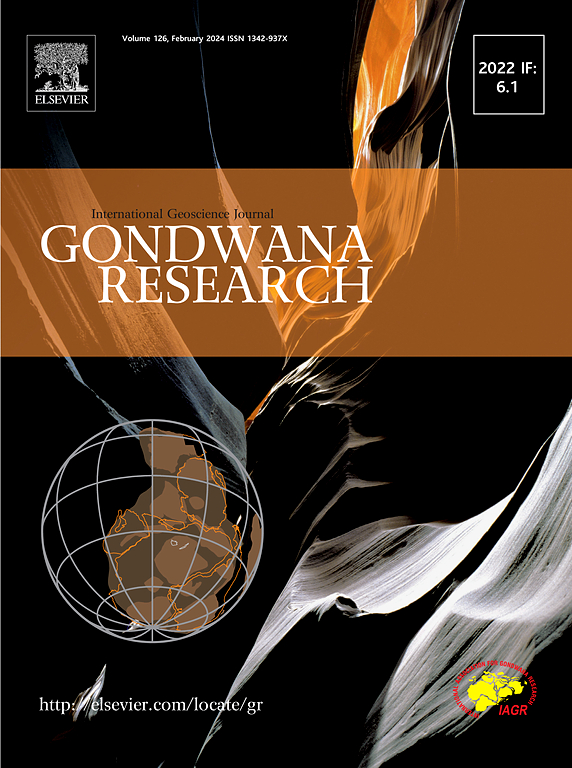The Igla Sn-(W-Be) deposit, Egypt: Prolonged magmatic-metasomatic processes during the middle stage evolution of the Arabian-Nubian Shield
IF 7.2
1区 地球科学
Q1 GEOSCIENCES, MULTIDISCIPLINARY
引用次数: 0
Abstract
The Igla Sn-(W-Be) deposit in the Central Eastern Desert of Egypt is associated with a suite of granitic rocks, including monzogranite, granophyric granite, and porphyritic leucogranite. These rocks belong to a calcic to calc-alkalic series, characterized by low Mg# values and low Ti and P concentrations. Monzogranite and granophyric granite show features typical of fractionated volcanic-arc I-type granites, while the leucogranite, with its distinct Rb/Ba, K/Rb, and Ga/Al ratios, is classified as a highly evolved A-type granite. Mineralization at Igla mine includes cassiterite and wolframite, along with minor molybdenite, arsenopyrite, columbite, and tourmaline, mainly hosted in beryl ± topaz-quartz veins and miarolitic cavities within greisen and silica-rich stockwork.
Zircons from the monzogranite show LREE enrichment, moderate positive Ce anomalies, and moderately oxidizing conditions (ΔFMQ ≃ 1.75), while granophyric granite zircons exhibit higher HREE enrichment and more oxidizing conditions (ΔFMQ ≃ 1.04). Leucogranite zircons have the highest REE concentrations, more pronounced negative Eu anomalies, and distinctly reducing conditions (ΔFMQ ≃ -0.06). U–Pb dating of zircon and xenotime reveals concordant 206Pb/238U ages of 708.7 ± 2.0 Ma for monzogranite, 701.3 ± 1.5 Ma for the granophyric granite, and a noticeably younger age for the leucogranite (605.1 ± 2.4 Ma).
Petrography and microchemistry of cassiterite reveal two distinct stages: an earlier generation (Cst-I) with straight oscillatory zoning, and a later chaotically zoned generation (Cast-II) that overgrows and crosscuts the former. U-Pb dating confirms two discernable age populations: Cst-I, with a weighted mean 206Pb/238U age of 637.4 ± 1.4 Ma; and Cst-II ages scatter from 605 to 588 Ma, partially overlapping with the leucogranite formation. Wolframite, although less precisely dated at 615.3 ± 4.3 Ma, suggests rejuvenated tectonics, magmatism, and hydrothermal activities, culminating in the formation of Cst-II. Primary aqueous fluid inclusions in quartz indicate deposition from a low-salinity aqueous fluid with undetectable dissolved gas, while trails of aqueous-carbonic inclusions with slightly higher salinity and appreciable gas (CO2, CH4) contents occur together in the same crosscutting trails with arsenopyrite and bismite inclusions. The variable contents of CO2 and CH4 in these inclusions suggest that carbon redox equilibria within the ore-forming fluid may have played a pivotal role in linking redox potentials, facilitating the deposition of arsenopyrite, bismite, and Cst-II.
The improved age constraints highlight the role of highly evolved transcrustal magmatism in mobilizing and upgrading early rare metal concentrations, coinciding with the ∼ 650–600 Ma geodynamic transition in the Arabian-Nubian Shield. Crustal thinning, partial melting of older granitoids, and prolonged magmatic-hydrothermal interactions were key in ore formation and upgrading.

埃及伊格拉锡(W-Be)矿床:阿拉伯-努比亚地盾中期演化过程中延长的岩浆交代作用
埃及中东部沙漠的伊格拉锡(W-Be)矿床与一套花岗质岩石有关,包括二长花岗岩、花岗花岗岩和斑状浅花岗岩。这些岩石属于钙—钙碱性系列,具有低Mg#值和低Ti、P浓度的特征。二长花岗岩和花岗花岗岩表现出分馏型火山弧型花岗岩的典型特征,而浅色花岗岩则表现出明显的Rb/Ba、K/Rb和Ga/Al比值,属于高度演化的a型花岗岩。Igla矿化主要为锡石、黑钨矿,伴少量辉钼矿、毒砂、柱长石、电气石,主要赋存于绿柱石±黄玉石英脉和富灰硅网中的微晶洞中。二长花岗岩锆石表现出LREE富集、中等正Ce异常和中等氧化条件(ΔFMQ≃1.75),花岗花岗岩锆石表现出较高的HREE富集和较高的氧化条件(ΔFMQ≃1.04)。浅色花岗岩锆石稀土浓度最高,负铕异常较为明显,且还原条件明显(ΔFMQ≃-0.06)。锆石和xenotime的U-Pb定年结果显示,二长花岗岩的206Pb/238U年龄一致,为708.7±2.0 Ma,花岗花岗岩为701.3±1.5 Ma,浅花岗岩的年龄明显较低,为605.1±2.4 Ma。锡石的岩石学和微化学特征表明,锡石的早期阶段(Cst-I)具有直接的振荡分带,而晚期的混乱分带(Cast-II)则覆盖和横切了前者。U-Pb测年证实了两个可识别的年龄群体:Cst-I,加权平均206Pb/238U年龄为637.4±1.4 Ma;Cst-II年龄分布在605 ~ 588 Ma,部分与浅花岗岩地层重叠。虽然黑钨矿的年代不太精确,但它的年代为615.3±4.3 Ma,表明构造、岩浆活动和热液活动恢复了活力,最终形成了Cst-II。石英原生水流体包裹体为低矿化度水溶液沉积,溶气未检出,而含盐量略高且气体(CO2、CH4)含量可观的碳水包裹体轨迹与毒砂和铋矿包裹体在同一横切轨迹中同时出现。这些包裹体中CO2和CH4含量的变化表明,成矿流体中的碳氧化还原平衡可能在连接氧化还原电位中发挥了关键作用,促进了毒砂、铋和Cst-II的沉积。改进的年龄限制突出了高度演化的跨地壳岩浆作用在动员和提升早期稀有金属浓度中的作用,与阿拉伯-努比亚地盾的~ 650-600 Ma地球动力学转变相吻合。地壳变薄、较老花岗岩类的部分熔融和岩浆-热液相互作用的延长是成矿和升级的关键。
本文章由计算机程序翻译,如有差异,请以英文原文为准。
求助全文
约1分钟内获得全文
求助全文
来源期刊

Gondwana Research
地学-地球科学综合
CiteScore
12.90
自引率
6.60%
发文量
298
审稿时长
65 days
期刊介绍:
Gondwana Research (GR) is an International Journal aimed to promote high quality research publications on all topics related to solid Earth, particularly with reference to the origin and evolution of continents, continental assemblies and their resources. GR is an "all earth science" journal with no restrictions on geological time, terrane or theme and covers a wide spectrum of topics in geosciences such as geology, geomorphology, palaeontology, structure, petrology, geochemistry, stable isotopes, geochronology, economic geology, exploration geology, engineering geology, geophysics, and environmental geology among other themes, and provides an appropriate forum to integrate studies from different disciplines and different terrains. In addition to regular articles and thematic issues, the journal invites high profile state-of-the-art reviews on thrust area topics for its column, ''GR FOCUS''. Focus articles include short biographies and photographs of the authors. Short articles (within ten printed pages) for rapid publication reporting important discoveries or innovative models of global interest will be considered under the category ''GR LETTERS''.
 求助内容:
求助内容: 应助结果提醒方式:
应助结果提醒方式:


